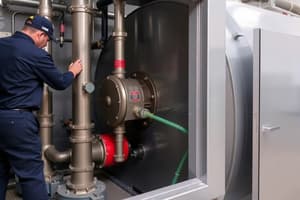Podcast
Questions and Answers
What is the phase change that occurs when water reaches its boiling point?
What is the phase change that occurs when water reaches its boiling point?
transforms into steam
Which energy sources can be used to heat water in a boiler?
Which energy sources can be used to heat water in a boiler?
- Oil (correct)
- Coal (correct)
- Electricity (correct)
- Natural gas (correct)
The steam cooling process occurs in a condenser.
The steam cooling process occurs in a condenser.
True (A)
What is the purpose of the feedwater pump in the water-steam cycle?
What is the purpose of the feedwater pump in the water-steam cycle?
The process of heat transfer through direct contact between materials is known as _____
The process of heat transfer through direct contact between materials is known as _____
What happens to steam after it performs its work, such as turning a turbine?
What happens to steam after it performs its work, such as turning a turbine?
What is the Ideal Rankine Cycle used for?
What is the Ideal Rankine Cycle used for?
Which of the following processes involves the movement of fluid molecules from high to low temperature regions?
Which of the following processes involves the movement of fluid molecules from high to low temperature regions?
Flashcards are hidden until you start studying
Study Notes
Boiler Operation
- The water-steam cycle is a key concept in boiler operation.
- Water Heating: The process starts by heating water in a boiler using various energy sources. This process leads to the formation of steam when the water reaches its boiling point.
- Steam Production: The transition from liquid water to steam involves absorbing a significant amount of heat known as latent heat.
- Steam Collection: After steam production, it's collected in a steam drum or header, where it can be separated from any residual water.
- Steam Distribution: The steam is directed through pipes to where it will be used for different applications such as electricity generation, heating systems, or industrial processes.
- Condensation: After performing its work, the steam condenses back into water. The steam releases its latent heat to a cooling medium, often in a condenser.
- Water Return: The condensed water in liquid form is returned to the boiler to be reheated and turned back into steam, completing the cycle.
Properties of Steam Generation
- The process of steam generation involves heat transfer.
- Conduction: Thermal energy transfer within a material or between materials in direct physical contact.
- Convection: Movement of fluid molecules from regions of higher temperature to regions of lower temperature.
- Radiation: Thermal energy transfer through electromagnetic waves, typically in the infrared spectrum.
- The ideal Rankine Cycle, also known as the water-steam cycle, is a thermodynamic process widely used in power generation, particularly in steam turbines found in various energy sources like coal, natural gas, nuclear, and solar thermal.
Studying That Suits You
Use AI to generate personalized quizzes and flashcards to suit your learning preferences.




